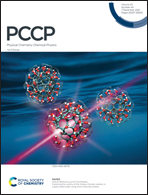Six- or four-fold band degeneration in CoAs3, RhAs3 and RhSb3 topological semimetals†
Abstract
Searching for new topological phases of matter has long been a hot topic in condensed matter physics and materials science based on its fundamental physics and promising device applications. Here we report a systematic ab initio study on the topological electronic properties of CoAs3, RhAs3, and RhSb3 binary compounds. Without spin–orbit coupling, there is a six-fold band crossing node at the high-symmetric Γ point with topological charge  , which is denoted as “six-fold excitation”. This nodal point is formed by the highest occupied band and two of the lowest unoccupied bands, and protected by time-reversal symmetry, and spatial-inversion symmetry and stabilized by the two-fold rotational symmetry. Detailed band structure and elementary band representation analysis shows that the six-fold band degeneracy at the Γ point near the Fermi level is formed by the bands of Ag@8c originating from the d-orbital of metal atoms. Meanwhile, with spin–orbit coupling, the six-fold nodal point becomes a four-fold degenerate quadratic Dirac point with the topological charge conserved as
, which is denoted as “six-fold excitation”. This nodal point is formed by the highest occupied band and two of the lowest unoccupied bands, and protected by time-reversal symmetry, and spatial-inversion symmetry and stabilized by the two-fold rotational symmetry. Detailed band structure and elementary band representation analysis shows that the six-fold band degeneracy at the Γ point near the Fermi level is formed by the bands of Ag@8c originating from the d-orbital of metal atoms. Meanwhile, with spin–orbit coupling, the six-fold nodal point becomes a four-fold degenerate quadratic Dirac point with the topological charge conserved as  . These results provide a systematic understanding of the electronic properties of the skutterudite compounds and enrich the families of topological fermions in condensed matter systems.
. These results provide a systematic understanding of the electronic properties of the skutterudite compounds and enrich the families of topological fermions in condensed matter systems.



 Please wait while we load your content...
Please wait while we load your content...